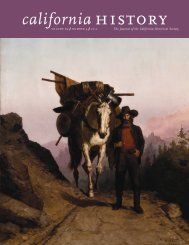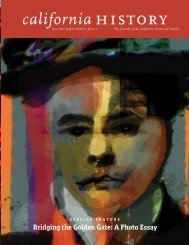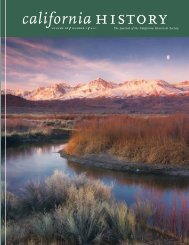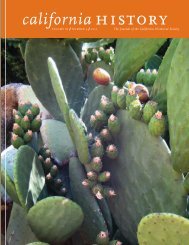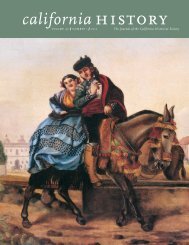california history - California Historical Society
california history - California Historical Society
california history - California Historical Society
You also want an ePaper? Increase the reach of your titles
YUMPU automatically turns print PDFs into web optimized ePapers that Google loves.
are building a park on the land. We will take careof it and guard it, in the spirit of the CostanoanIndians. When the University comes with itsland title we will tell them: ‘Your land title is coveredwith blood. We won’t touch it. Your peopleripped off the land from the Indians a long timeago. If you want it back now, you will have tofight for it again.’” This politicization of People’sPark did not scare off the counterculture. Delacour,for example, believed that Bardacke hadmerely brought out the implications with “thewhole user thing which the Indians had” thatwere always inherent in the park issue. Nor didradicalization prevent the participation of moremoderate elements of the south campus community.John Coleman, a Berkeley graduatestudent, neighborhood resident, ordained priest,and self-described “part of the ‘Silent Majority,’”later depicted People’s Park as “a place of delightand whimsy”: “Street people in colorful hatsand costumes, students, middle-aged men withtheir teen-age sons, black and white, straight andhippie, they worked—sometimes two hundredstrong—in the hot afternoon sun, raking, digging,uprooting stubborn rocks, planting corn orflowers (some said they were marijuana), wateringsod. At the end of the afternoon they barbecued—sometimesa symbolic roast pig—drankwine and sang.” 28The formerly desolate vacant lot suddenly wastransformed by swings, slides, and sandboxes;flowers, grass, and three apple trees; abstractmetal sculptures, benches, and brick walkways.Alan Temko, architectural critic for the SanFrancisco Chronicle, praised the park’s foundersfor “starting a new era in democratic city planning”and pronounced People’s Park “the mostsignificant innovation in recreation design sincethe great public parks of the nineteenth and earlytwentieth centuries.” Van der Ryn compared theprocess of building the park to “the creation ofa frontier settlement” and the spirit of the parkbuilders to the heroic strain of “rugged individualism”prevalent in American <strong>history</strong> andfolklore. 29Twenty years later, Stew Albert reminisced nostalgically:“When people ask me, ‘What would yourpersonal view of heaven be like?’ I say, People’sPark. It was incredible. People were growingvegetables . . . people laying sod, planting rosebushes. There was a real kind of Walt Whitmanon a Sunday afternoon thing: a kind of blendingof play and work.” People’s Park, by bridging thechasm that once separated Bay Area politicos andhippies, exemplified the “hip-radical fusion” thatAlbert had envisioned. 30However, some Berkeley political radicals werenot thrilled with the partnership Albert hadbrokered. His former Progressive Labor comradesdismissed People’s Park as a “bourgeoisreformist” issue. In place of the Maoists, though,the park had gained the support of local southcampus residents, nonradicalized students, andfaculty sympathizers, making People’s Park farmore of a grassroots democratic movement thanits opponents realized. 31Act II: The Chancellor RespondsRoger Heyns arrived at UC Berkeley from theUniversity of Michigan in the autumn of 1965.An Iowa native, he had moved as a young childwith his family to Holland, Michigan. His devoutreligious upbringing convinced him to attendthe church-affiliated Calvin College, where hegraduated with a degree in psychology. At theUniversity of Michigan in Ann Arbor, he earneda master’s degree in psychology shortly beforeenlisting in the Army Air Corps in 1942. DuringWorld War II, he worked in the division of psychologicalservices, reaching the rank of captain.He returned to Ann Arbor after the war, receiveda doctorate in 1949, and joined the faculty. Anacclaimed teacher, he ultimately moved intoadministrative roles, first as dean and later asvice president for academic affairs. 321 <strong>California</strong> History • volume 88 number 1 2010



